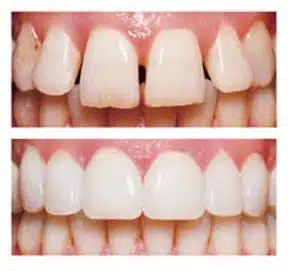In today’s challenging economic climate, people find themselves having to make every dollar they spend count. As a result, individuals considering cosmetic dental work face the additional problem of not having such procedures be covered by dental insurance. For some, that puts treatment a little farther out of reach.
While it may be a common perception that cosmetic dental procedures are completely elective, many prospective job seekers have come to realize that having an unattractive smile could make the difference between being hired and being passed over for employment.
One of the most common methods used to improve flaws in a person’s smile has been the use of dental veneers. These are typically thin shells of porcelain that are bonded to the surfaces of a patient’s teeth and can be used to correct a variety of problems: from unsightly old fillings to crooked teeth or chips in the teeth. They can also close gaps, lengthen short teeth, or permanently brighten discolored teeth.

Nevertheless, apart from the cost, their many advantages have made them a popular choice. There are several disadvantages, however. Among these is that most porcelain veneer procedures are irreversible. This means that the slight amount of tooth reduction necessary to create a natural appearance commits the patient to future veneers. Also, in most cases, multiple visits are required – with anesthesia. And should a veneer ever become damaged, or should it break, it is not easily repaired. It typically requires replacement.
Fortunately, an alternative form of treatment exists. As long as the dentist does not have to restore tooth decay as well, it can generally be performed without anesthesia.
This is known as a direct composite resin veneer. Instead of using porcelain to cover the tooth, a dentist places a very thin layer of composite resin – essentially, a tooth-colored filling material – over the tooth in order to create a similar effect. Whereas in the past, this solution sometimes resulted in a dull, lifeless appearance for a tooth, current composite resins available to dentists have improved significantly. Products on the market today have enhanced physical and optical properties that also allow the dentist to accomplish a dramatic change in a patient’s appearance in as little as one visit.
Many composite resins can also be placed with little or no alteration of the tooth’s structure. Every person’s case is different, however. Your dentist should be able to give you an idea of what will be required to obtain the optimal esthetic result for your case. Expect to pay anywhere between $350 to $695 per tooth.
What if you break or chip a composite resin veneer? The repair is usually easy to accomplish in a single visit and at a significantly reduced cost to replacing a porcelain veneer. Are there any disadvantages? Frankly, these are among the most technique sensitive of all dental veneers. The skill of the dentist and their attention to detail are critical elements in achieving a good result.
Talk with your doctor about which options are right for you. It may still be possible for you to enjoy the benefit of veneers – at nearly half the cost. Most dental offices today offer flexible financing options, many of which are interest free. Your perfect smile may be much closer than you think!





